The Kia EV6 goes around corners like it’s on rails. The electronic aids plus the electric motor would be terrific for track times once people master it.
Introduction
The electric vehicle market in India has been steadily growing and offerings from many manufacturers are on sale in the country. Tata Motors leads the way with the Tigor EV (priced at Rs. 12.49 – 13.64 lakh) and Nexon EV (priced at Rs. 14.79 – 19.24 lakh), while MG sells the ZS EV (priced at Rs. 22.00 – 25.88 lakh), which is the most sorted EV this side of the luxury marques. There is also the Mini Electric, priced at 48.70 lakh. These cars are doing well in their respective price brackets and since there are no other electric models on offer in their segments, they are ruling unchallenged.
Then, there is a big price jump and the EVs in the next segment (Audi e-tron, BMW iX, Jaguar I-Pace and Mercedes EQC) are priced around Rs. 1 crore.
Now, Kia is entering the EV market in India with the EV6 “crossover”, which is aligned to what the company terms “Techno Green Innovation”. The car will be brought to India through the CBU route (VIN details indicated that the cars used for the drive at Buddh International Circuit were built in Korea). The EV6 will be positioned above the Carnival in Kia’s product portfolio, making it the new flagship product. During the presentation, there was reference to the Tesla Model Y, which should be an indicator as to how Kia plans to price the EV6. We expect it to be priced in the range of Rs. 60 – 75 lakh. This will mean that the car has no challengers in its price bracket, at least till the time the Hyundai Ioniq 5 or Volvo XC40 Recharge are launched. Kia has allotted 100 units for the Indian market for the first year and bookings will open on May 26, 2022.
The EV6 is Kia’s first ground-up EV. It is based on Hyundai Group’s Electric-Global Modular Platform (E-GMP) and features Kia’s “Opposites United” design philosophy. It will be offered with a permanent magnet synchronous motor and a 77.4 kWh lithium-ion battery pack. The battery supports ultra-fast charging, which adds 100 km of range in 4.5 minutes. It can be recharged from 10% – 80% in 18 minutes using a 350 kW fast charger (good luck finding that in India), while a 50 kW fast charger takes 73 minutes for the same.
Kia claims that the EV6 offers a range of more than 500 km as per European test norms (AER). It is expected to manage perhaps over 500 km in ARAI tests. The car’s homologation is going on and the exact range will be announced during the launch on 2nd June.
The EV6 will be offered in the GT Line trim with both, single motor and dual-motor variants. The single motor RWD variant packs 226 BHP and 350 Nm, while the AWD version produces 222 BHP & 350 Nm at the front / 98 BHP & 255 Nm at the rear. That’s a combined output of a whopping 321 BHP and 605 Nm!
The exterior design is very bold and stylish with sleek lines and contours that run all along the body line + the bonnet. Smart use of design elements can be seen all over the car. For a change, everything somehow falls in place without anything glaringly standing out, which hasn’t been the case with many new cars. This car looks very sharp and would be well accepted by a wide audience, without polarising opinions. The EV6 rides on 19″ alloy wheels shod with 235/55 section tyres. What’s noteworthy is that the car’s ground clearance has been increased from 165 mm to 178 mm for India! Very, very important IMHO.
The car will come in 5 colours – Moonscape (our personal favourite), Snow White Pearl, Runaway Red, Aurora Black Pearl and Yacht Blue. The Aurora Black reminded me of my friend’s Standard (Rover) 2000, which he had painted shiny jet black, back in the 1990s.
The interiors, on the other hand, come in only one colour option, which is black. The quality and feel of the materials used is mostly very good and there are some nice, premium touches like the checkered finish on the passenger side of the dashboard and brushed aluminum on the central console. However, if you are expecting premium-class wood veneer and polished surfaces, you are in for a disappointment. On the other hand, you can expect everything to be well put together and long lasting, made with European flavor in abundance. While the cars used for our preview drive had different materials for the seats, the ones that will be sold in India will have black suede & off-white vegan leather upholstery. The choice of “vegan” is part of Kia’s green initiatives for the future. I found the front seats to be super comfortable. They have all the adjustments one will normally ask for. The seats are sporty and super supportive.
While the black interiors will not get soiled easily, the dark shade of the upholstery along with the sloping roof line at the back, makes rear seat passengers feel claustrophobic. Rear legroom is abundant, especially with the front seats moved forward or even set for sub-6-foot-tall front users. The flat floor helps in extracting more space at the rear. The downside is that, with the overall raised floor due to the battery placement, the under-thigh support is negligible. This is not really a car for sitting in the rear seat on long drives.
Luggage space is good enough with a 520L boot, and a 20L (AWD) or 52L frunk (RWD). The boot floor has an additional removable section, which can increase the loading area depth by about 2 inches. It can also be used to store valuables out of sight. There is no spare wheel, not even a space saver! No tools provided either. This will pose major problems in real life driving conditions as India isn’t like Europe or USA where you can try roaming without a spare wheel. A subwoofer, along with the rest of the EV stuff, occupies the place of the spare wheel, jack and tools.
One needs to be cautious while folding the rear seatbacks from the boot. While it is super convenient, pulling the lever folds the seats rather hard and fast. So, if there are delicate items kept on the rear seat, expect them to be crushed. The folding mechanism is built tough, but that makes it equally tough to pull the seat back in place.
The young tech-savvy entrepreneur, who according to Kia is the potential customer, will expect a lot at the price at which the EV6 is likely to be launched. So, it is inevitable that the car has to be very well equipped. Kia has loaded the EV6 with all the features one would expect. Some of the features available include dual 12.3″ screens, 10-way power-adjustable front seats with memory function for the driver’s seat, suede & vegan leather upholstery, dual-zone automatic climate control, UV cut glasses, paddle shifters for regeneration, multi-drive modes, connected car technology, adaptive headlamps, rain-sensing wipers, vehicle-to-load and a wireless smartphone charger. The GT-Line AWD variant (which we drove) comes with an Augmented Reality head-up display, powered tailgate, sunroof (not panoramic), automatic flush-fitting door handles and a Meridian sound system with 14 speakers.
If the geek in you wants to see what the 12.3″ screens can do, go ahead and check out this link. You scan a QR code on the system to get this link on your smartphone. Let me assure you that it will take at least half a Sunday for you to just go through the various menus and settings on this one. Good thing that most of them are, at best, 3-4 clicks deep.
On the safety front, the EV6 comes equipped with 8 airbags, 360-degree camera, adaptive LED headlights, all-wheel disc brakes with ABS and brake assist, ESC, hill-start assist control, multi collision brake assist, VSM as well as ADAS. The list of ADAS features includes forward collision avoidance assist, lane keep assist, safe exit assist, lane follow assist, blind-spot detection with collision-avoidance assist, rear-cross traffic alert and smart cruise control with stop & go functionality. All the radar-based systems are configured for the real world and hence, would not work on a wide track like the Buddh International Circuit. Some of the instructors managed to get lane guidance working in a few corners.
You will never run out of charging points in this car. You can use this EV as a massive power bank to charge your gadgets and gizmos…and then some. At the front, there are two USB ports, two 12V power outlets and a wireless charging pad. Rear passengers get two USB ports and one full-fledged 250V 16A power outlet. Then, there is another power outlet in the boot. If these are not enough, one can easily run any household appliance including a microwave, plasma TV and even a refrigerator using the Vehicle to Load (V2L) connection. We’re not kidding! The plasma TV used for the presentation was powered from the display car! One can even help fellow EV owners with a top up, if they run out of juice through a Vehicle to Vehicle (V2V) connection using a regular ICCB cable.
Driving the Kia EV6
It was our bad luck that it started raining cats & dogs at 6.00 AM in Greater Noida, and when we reached the Buddh International Circuit at 7.00 AM, there was a full-fledged storm. At 9.00 AM, it was not clear whether the track would be opened for the drive. We saw steel plates flying off and falling in the pit area, barely missing an EV6. Things somehow mellowed down and it was decided that we will have a brief session on the track. We were reminded multiple times of the conditions; these were normal street cars and needed to be treated accordingly. We started with an instructor at the wheel for a demo drive on a short loop of Buddh. The track was wet, but the car behaved well with moderately aggressive turn-ins. The traction control system along with the electric motors, makes it very safe and does not allow for any unwanted spins or slips like internal combustion engine cars. It feels and is very safe that way.
Then came my chance to have my two short laps of the circuit. The longer lap was yet to be cleared for driving. Turn the jog dial from P -> D and start off slowly. The EV6 will drive just like any other car, minus the sound from the engine. Mind you, the only EV I had tried before this was an Ather – a small, peppy scooter that goes off with a “wheeee”. But in an EV6, there is absolute silence. There is no whine or any other audio feedback, unless you switch on the electronics which play different themes over the speaker. I would personally keep them off and instead, switch on the relaxing tones option and enjoy the Zen-like calm. Depending on the pressure on the accelerator pedal, the power drive will be gentle, mild or shove you back into the seat.
There are 3 driving modes:
- Eco – Feels like how a normal 150-180 BHP turbo-charged car would.
- Normal – Gives you about 30% more rush. While keeping the A-pedal at the same position, you hit the drive mode button on the steering wheel to engage Normal mode from Eco and the car will lunge forward eagerly with this change. There is a remarkable difference.
- Race – Lets all the kV’s into the motor and makes it a maniac. Expect yourself to be shoved back into the seat with the passengers screaming. We did a dash from 0 to 100 km/h in 5.6-ish seconds with 3 adults in the car. In a matter of seconds, you are doing silly speeds. This car has an electronically-limited top speed of 192 km/h and we could easily achieve that on the straight stretches of the track, even in wet conditions! There is absolutely no wheel spin or drama. The electric motor along with the electronics ensures that all the power is put on the ground and not even 1 kV is wasted.
- Snow – This mode is hidden. One needs to press and hold the mode button to activate it. We missed driving in this mode, but I guess it is for tricky, slippery conditions that you find in cold countries during the winter.
The same mix of electric motors and the various stability programs can make the driving experience very uninvolving and boring on turns. In a normal internal combustion engine car, there is a lot of feedback that the driver will receive from the steering, engine, gearbox and brakes. In an EV, there is just the steering and then, the regen braking and normal brakes. The missing engine makes a huge difference to the driving experience for someone new to EVs.
The regenerative braking system has four levels, from mild to hard. This can be quickly accessed by using the paddles, which is well thought out. It’s just like using the paddles for downshifting to get more and more engine braking. In the highest regen mode, this vehicle can be driven with just the A-pedal. The regen braking can bring the vehicle to a stop. Hence, a keen and focussed driver would be able to recover a lot of lost energy during normal driving, enhancing the usable range. Then, there is “Auto” mode, which adjusts the regen braking based on various parameters including radar-guided cruise control (if activated) or on driver inputs. When I tried to use the paddles in Auto mode, the system kept flashing a message saying, “conditions are not met”, so I assume the paddles were being bypassed or the braking, along with the wet conditions, did not allow it to get more aggressive. Personally, I am a big fan of this regen braking, especially with the paddles. I felt that brings some fun and involvement into driving an EV.
Handling-wise, the car is very neutral. You can push it extremely well. I have driven normal ICE cars such as the Volkswagen Polo GTi, Jaguar F-Type, Mercedes AMG and BMW M cars, and ridden shotgun in Ferraris on tracks around the world and all of them need a good deal of driver attention in corners or they will bite back, squirm and squeal. The EV6 – on the other hand – just goes around corners like it’s on rails. The electronic aids plus the electric motor would be terrific for track times once people master it. Again, there is no intrusive traction control cutting in. It is all seamless. During the entire drive, only one momentary intervention I could sense was in the steering and that too when I took an aggressive turn + the wheels were on the wet kerbs. The whole car with its sound deadening, EV tech, etc. make it a very Zen-like place to be. One would love it or hate it, missing all the sensory feeling of riding in a normal motor car (sorry internal combustion engine car), while there would be others who appreciate the refinement.
Coming to the ride, the EV6 seems to be decent from our experience when we tried it on whatever undulated surfaces we could find inside the circuit, but it would be foolish to say it is great from just this drive. I feel the suspension set up is on the stiffer side, but definitely does not feel like a bone-jarring one. We’ll be driving this car on regular roads soon and will update the thread.
Front end features a sleek clamshell bonnet along with adaptive LED headlamps, and an angular lower bumper that accentuates the width of the car:
Rear is where you will see some bulk, but those LED lamps with a jewel like arrangement for the turn-indicators are pretty neat:

The side is the best angle to view the car from, with the character lines clearly visible. There is a silhouette puddle light that is hidden on the C-pillar (yes, C-pillar):

Closer look at the headlamp cluster with integrated multi-array front indicators:

Fully protected and absolutely flat undercarriage. Battery area has a metal plate, but the rest of it is a fiber and plastic combo. 178 mm ground clearance should be adequate:

Powered recharge flap. Those lines indicate the charge level and charging:
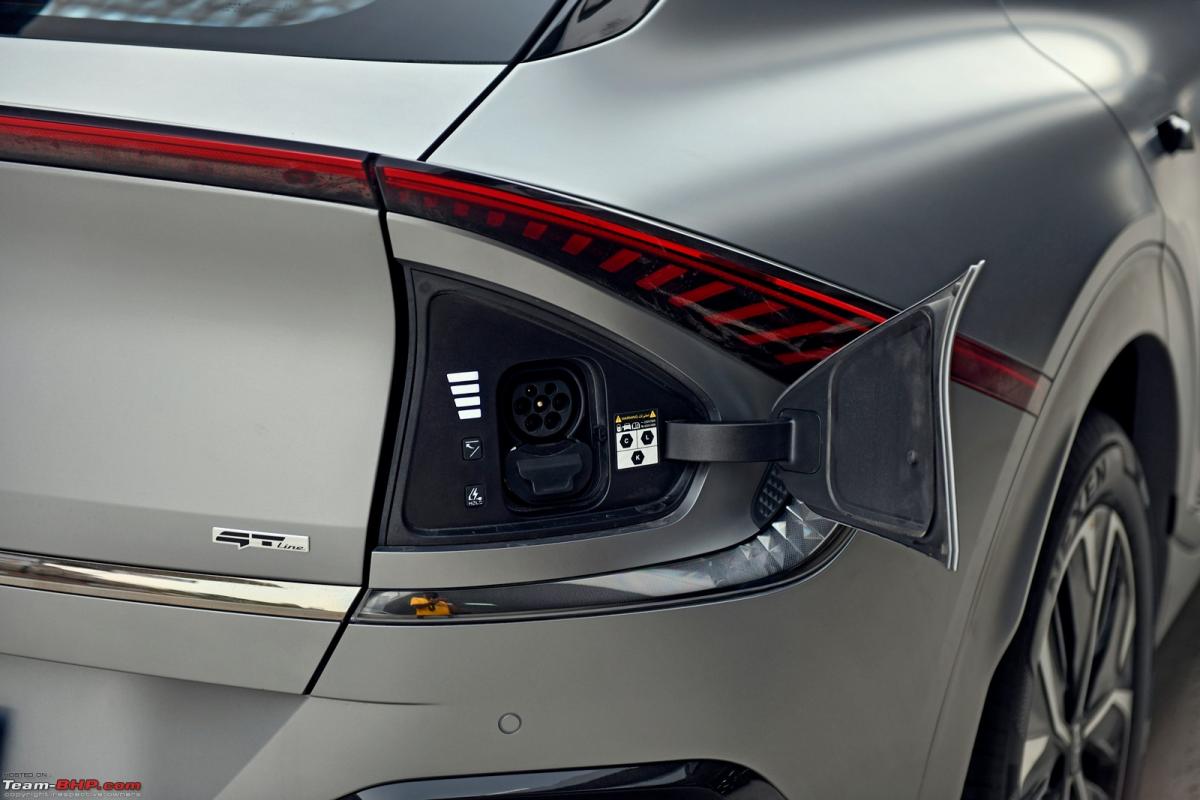
With the rear LED turn-indicators in action. Otherwise, they look like brushed aluminium jewels. Neat touch:

Here is the EV6 in the Aurora Black Pearl paint. How many of you are reminded of the Standard 2000? A modern take on it, we feel:
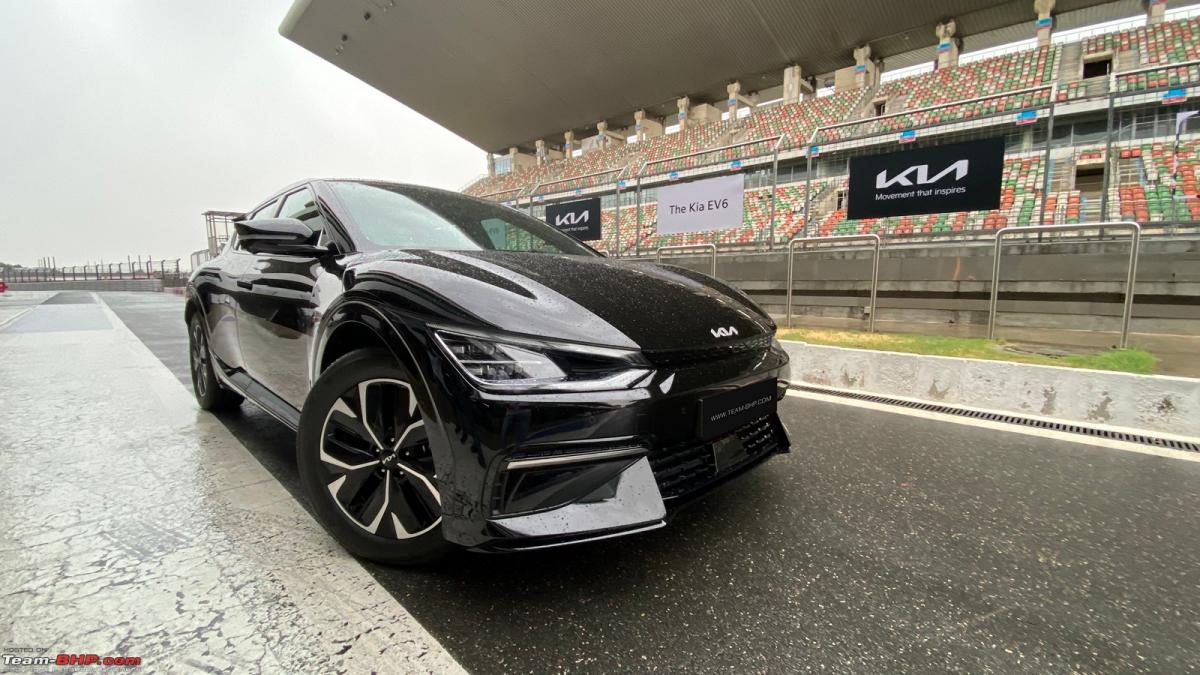
Here is the EV6 in the Aurora Black Pearl paint. How many of you are reminded of the Standard 2000? A modern take on it, I feel:
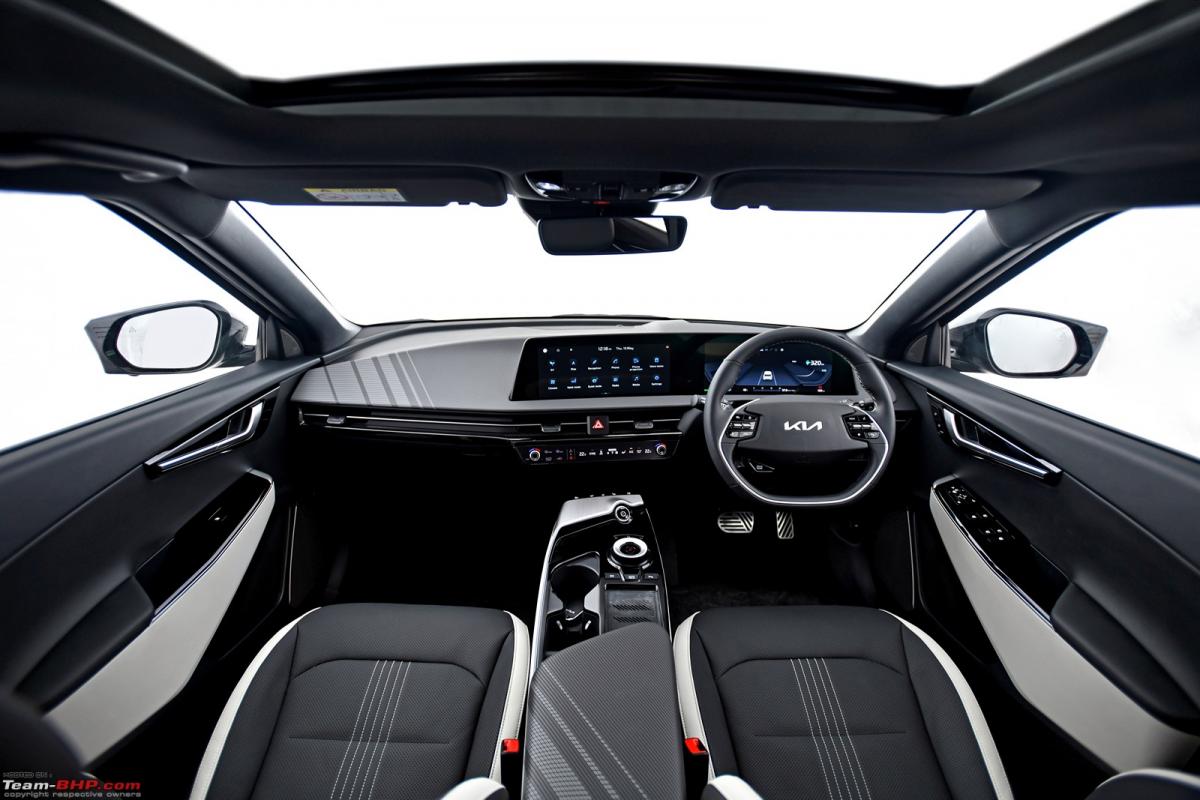
The displays seem to be the right size and not just a huge tablet in your face. There are two screens here – one for the infotainment head-unit and a second one for the instrument cluster:
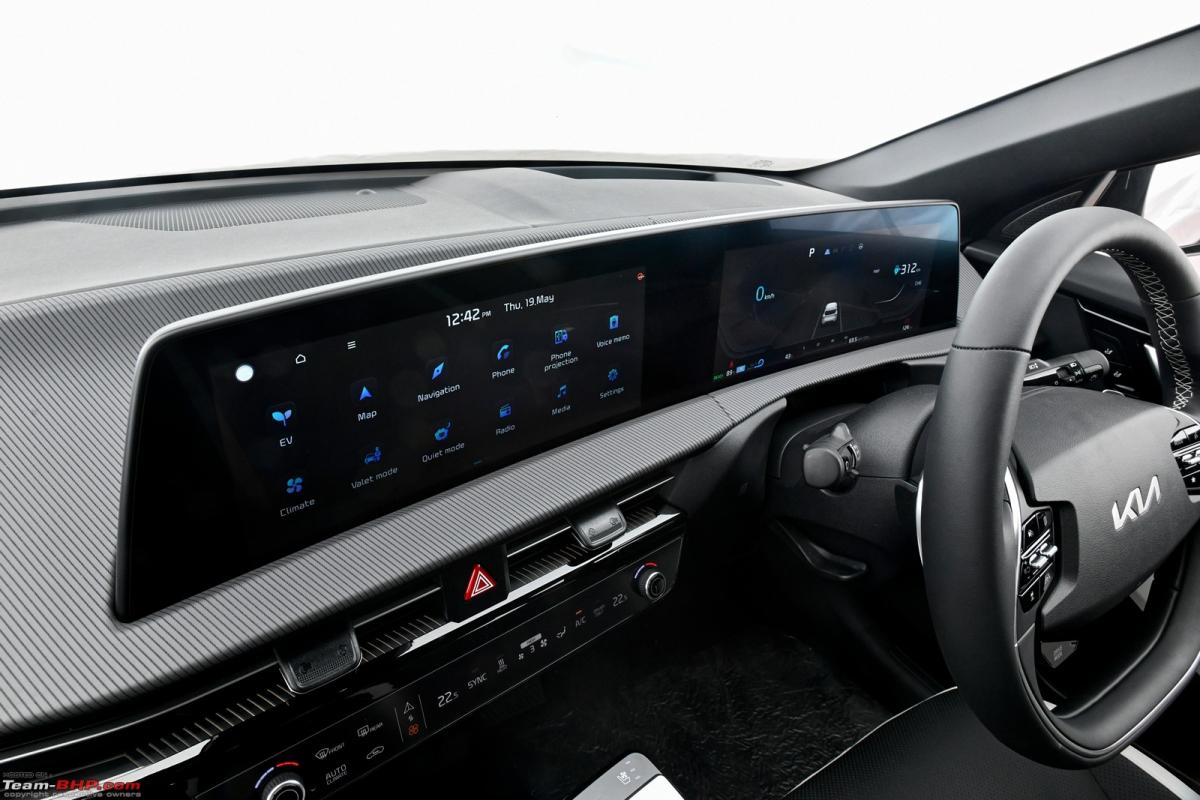
Seats have the right bolstering and the headrest is not intrusive, although it looks like the face of ET:
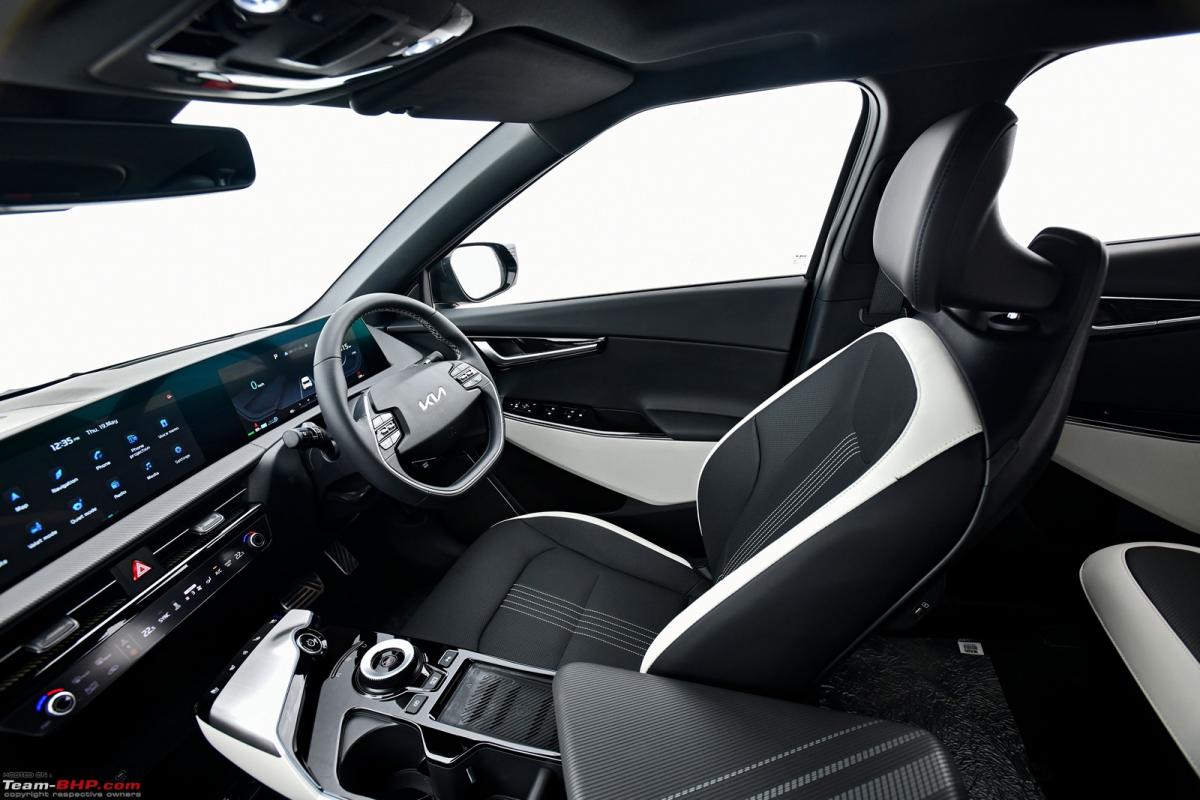
Touch controls have a mode button where the function changes from HVAC to media. This is tricky at first, yet easy to get used to and efficient use of space. Still, people may accidentally turn up the temperature instead of the volume:

It is a maze under the dash and you can see the power lines too:

The downside of all the design touches and battery being underneath. Your leg will get dirty if you are not careful. Shorter folks will find it a stretch to reach the ground:

Normally, the rear passenger has negligible under-thigh support:

With the front seat pushed ahead, the rear passenger can stretch his legs and then, the under-thigh support is alright. But this is not a very comfortable position to sit in for long:

This is not a large sneaker that I am wearing, yet there is no place underneath the front seat to put my feet:
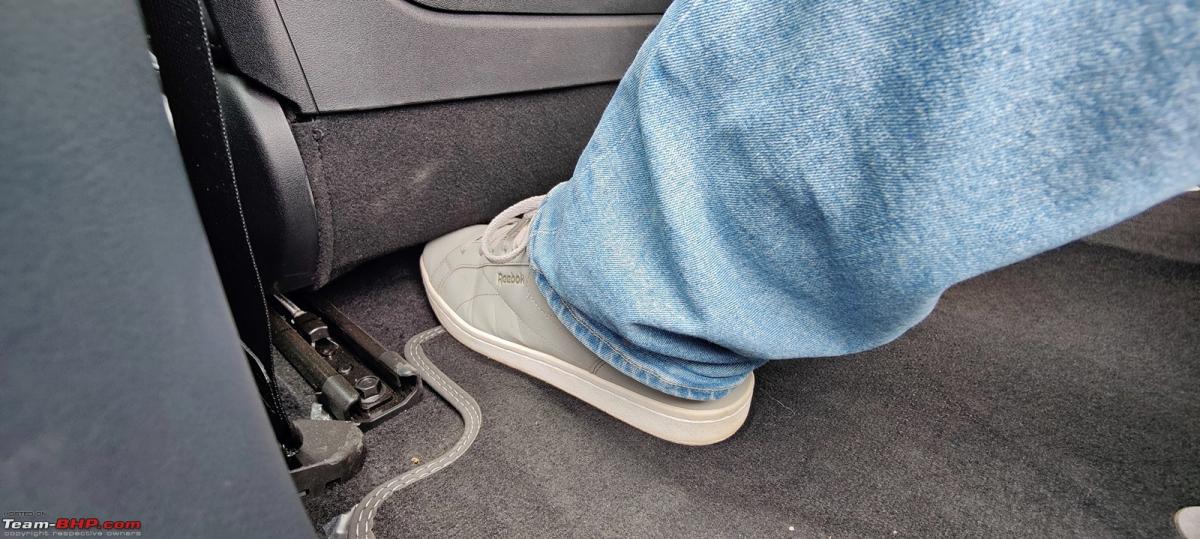
250V, 16A socket is a rare phenomenon even at homes as it is used only for heavy appliances. You can set up a full fledged office with this:

Small quarter glasses are the biggest reason to find it claustrophobic at the rear. Passengers will have their heads next to them while they are seated:
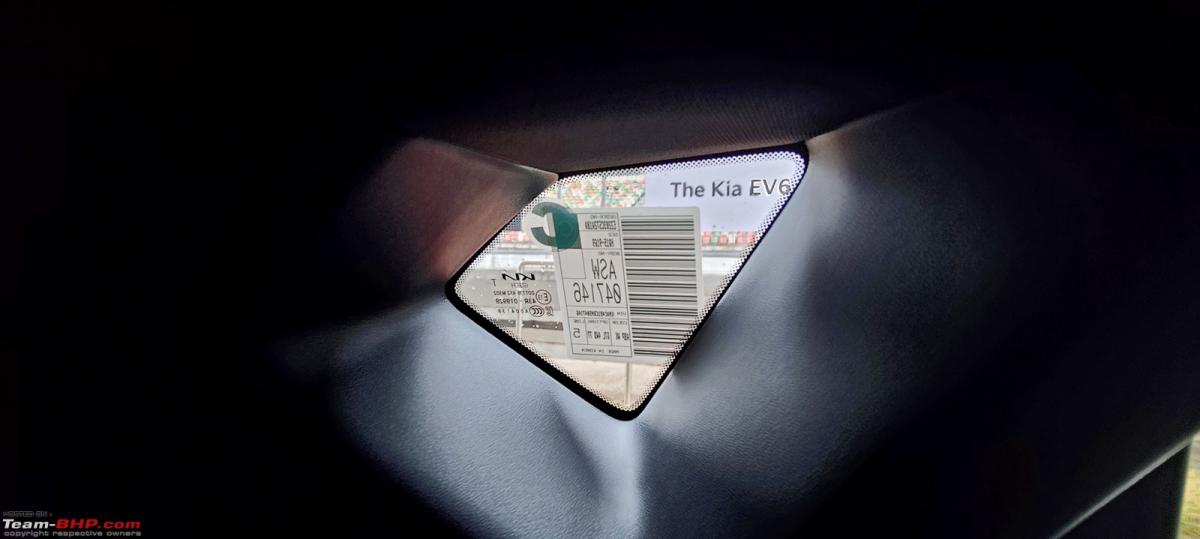
No dearth of space to carry that stuff for weekend camping. Rear seatbacks fold forward in a 60:40 ratio:

Notice the removeable boot floor. You can get 2 more inches of depth. Can store some valuables away from prying eyes here:

Folding the rear seat backrests gives you a luggage capacity of 1,300 liters. You can remove the parcel shelf. A camping bed can be easily accommodated along with a sleeping bag:

20-liter frunk is pretty much useless. That is an iPhone X kept in it to give you an idea about its size:

Continue reading the discussion on the 2022 Kia EV6 on our forum.